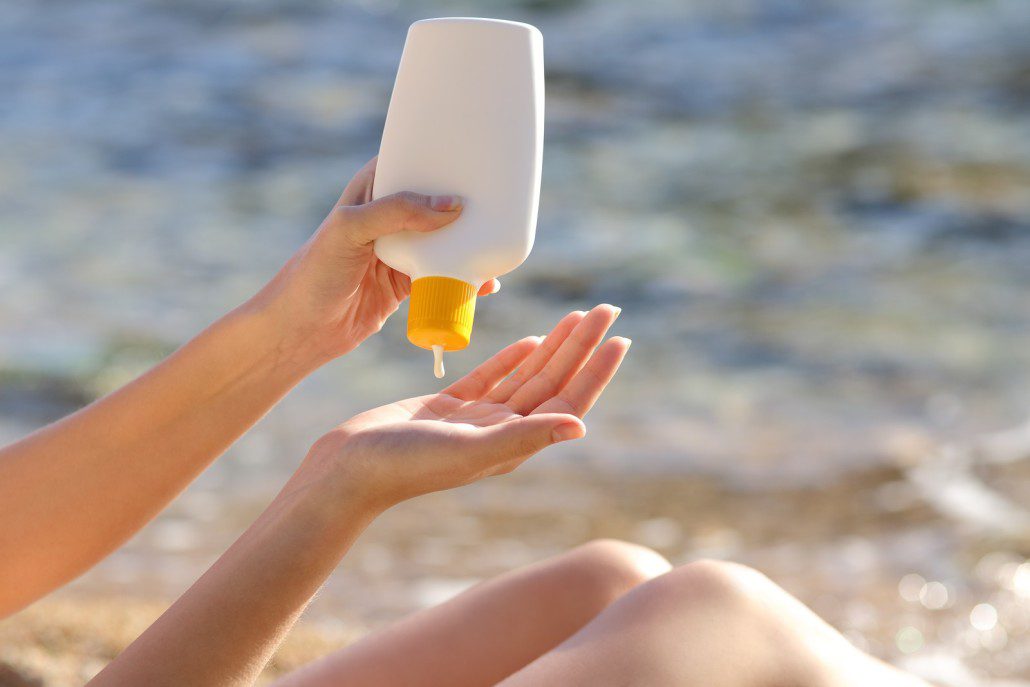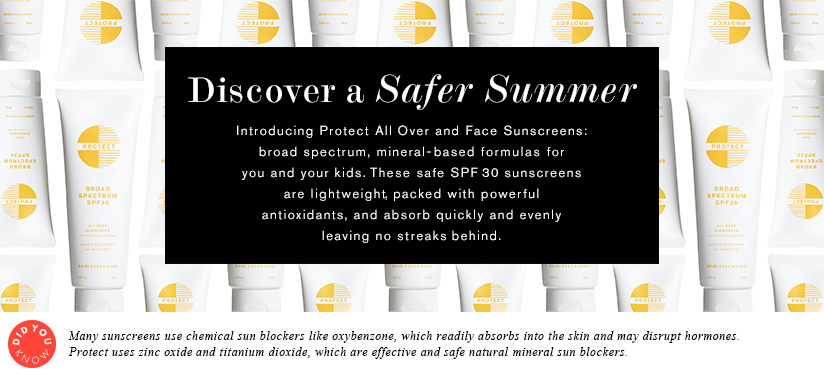Warning: the sunscreen in your beach bag may be hazardous to your health!

The sunscreen you’ve been lathering on yourself and your kiddos probably needs an upgrade. Let’s face it, sunscreen is little more than a tube of chemical soup that we absorb directly through our skin. Knowing this, we need to get smart about what products we’re using on ourselves and our kiddos.
Why Use Sunscreen?
Our skin is actually more susceptible to absorption in the summer. The heat and humidity opens up our pores, increasing the rate at which chemicals can enter the body through our skin.
Your skin does more than just cover you up, it acts as a physical barrier from our environment, limiting the passage of water and other substances in and out. Accounting for about 16% of your body weight, your skin helps to regulate your body temperature, protect against UV radiation, and it’s the first line defender when it comes to your immune system. Your immune system depends on your skin to act as a physical barrier so it doesn’t have to work in overdrive, scanning and assessing every single substance we come into contact with.
That being said, it’s important to know what products are safe to use on our bodies and what are not. Keep in mind when it comes to absorbing chemicals, it’s not as simple as whatever I slather onto my body gets inside my body. There are a number of layers that a chemical must pass through to actually get absorbed. If the chemical compound doesn’t pass through those outer skin layers, it’s only penetrated your skin. A chemical that just penetrates the skin doesn’t get absorbed and it doesn’t enter our bloodstream. Absorption occurs when the chemical breaks the skin’s barrier. Most, if not all, sunscreens break the skin’s barrier and are absorbed into our bloodstream.
Let’s not forget the reason we use sunscreen at all — to protect ourselves from the ultraviolet rays from the sun. Remember that there are two main types of UV rays: UVA rays and UVB rays. UVB rays are the ones that cause sunburn and trigger non-melanoma skin cancers (this is the slow-growing cancer that you can treat). UVB rays are also responsible for the synthesis of vitamin D through our skin. Sunscreens were designed to block UVB rays, slowing down the rate at which our skin burns and buying us some extra time out in the sun. An SPF of 30, for example, allows you can stay out in the sun 30 minutes longer, before you will burn. But this doesn’t mean the higher the SPF, the better. The EWG has warned for years that higher SPF sunscreens aren’t more effective and may even be worse for you than a lower SPF. You can read more about that here.

Sunscreen vs. Vitamin D
Vitamin D is synthesized by our bodies when UVB rays react with our skin. This is the most optimal way to get your vitamin D. There are actually very few food sources that are rich in Vitamin D. It’s almost impossible to meet your needs without the sunlight or a supplement, especially if you’re already deficient.
A major concern with sunscreen use is that when we use it before we head to the pool or the beach, we are preventing the production of vitamin D. Since more than half of my clients are deficient, I’d say this is a problem, and one that has pretty epic consequences. Vitamin D not only protects against osteoporosis and boosts your immune system, it also reduces the risk of breast, colon, kidney and ovarian cancers.
What to Avoid
As I mentioned before, sunscreen is quite literally a tube of chemical soup. There’s very little that’s natural in a bottle of this stuff. When choosing a sunscreen, there are a few ingredients you want to avoid.
Chemical sunscreens: First off, don’t use a chemical sunscreen. According to the EWG, sunscreens containing chemical filters typically include a combination of the active ingredients oxybenzone, avobenzone, octisalate, octocrylene, homosalate, and octinoxate. This group of chemicals are used mainly for their ability to absorb both UVA and UVB rays. Oxybenzone is the worst offender, mostly due to its endocrine-disrupting qualities and ease of absorption into the body. The CDC has predicted that oxybenzone can be detected in every American and is also found in human breastmilk. Sounds just like another nasty chemical we all know and avoid. BPA, anyone?
Nanoparticles: These are extremely small molecules, one billionth of a meter, that are often found in mineral sunscreens. Little is known about their safety, and their size means that they are easily absorbed into the bloodstream. The problem with nanoparticles is that they haven’t been tested on long-term health and there’s no requirement to label them in the US (even though other countries do). That being said, unless a brand tells you they aren’t in there, you’ll never know. Nanoparticles are dangerous when inhaled and the reason you should not use spray sunscreens.
Retinyl palmitate or retinol: Retinyl use is widespread in the cosmetics industry and has been for the last 40 years. These forms of vitamin A are only recently being studied for safety in the US and research shows they may speed the development of skin tumors when applied to sun-exposed skin. Other countries limit their use and warn that because they are so prevalent, cosmetics use may expose people to unsafe amounts of vitamin A. The EWG recommends that you avoid sunscreens, lip products, and skin lotions that contain vitamin A, also called retinyl palmitate, retinyl acetate, retinyl linoleate and retinol.
What I Recommend
Non-nano mineral sunscreens: Such as those using non-nano zinc oxide and titanium dioxide. I personally use Beautycounter’s entire line of sunscreen products. Mainly because nobody is going to the level they are for safety and effectiveness. They don’t use cancer-causing chemicals, endocrine disruptors, or ingredients that are linked to any human health concerns. Their mission is for safety, transparency, education, and updating the laws around cosmetics. Every product gets a safety rating of 0-2 on the Environmental Working Group’s skin deep database–so you don’t have to spend hours researching your products.
I use Beautycounter sunscreen at the beach and the pool or when exercising outside. It glides on super easily (without using nanoparticles!) and has no fragrance. I use their sunscreen stick on my daughters face and scalp. I use their Dew Skin tinted moisturizer with SPF on my face. This product is a 3:1 deal. It provides my daily sunscreen, anti-aging skin care, and a hint of color to blur those little imperfections. I also use their lip balm with SPF.
Seek out natural coverage: Think twice before slathering on sunscreen at the drop of a hat. Did you know that a typical T-shirt has an SPF rating of 15? Also consider sun-protective clothing with UV protection. And accessorize with a broad-brimmed hat and UVA and UVB blocking sunglasses.
Get some D: Take the first 10-15 minutes of your time in the sun and go sunscreen and sunblock free. Let the sun penetrate your skin (preferably your arms, legs, and face) before you reach for that bottle of sunscreen (or hide in the shade). Do this all year long, not just in the summer. According to the Vitamin D Council, you don’t need to tan or burn your skin to start vitamin D production. You only need to expose your skin for half the time it takes for your skin to turn pink and begin to burn (longer if you’re dark skinned).

